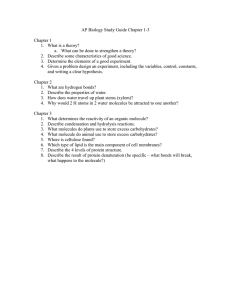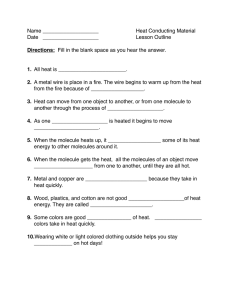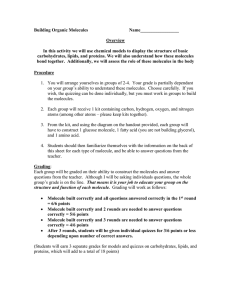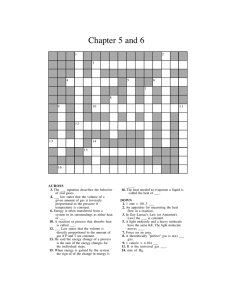Building Organic Molecules Name_________________ Overview
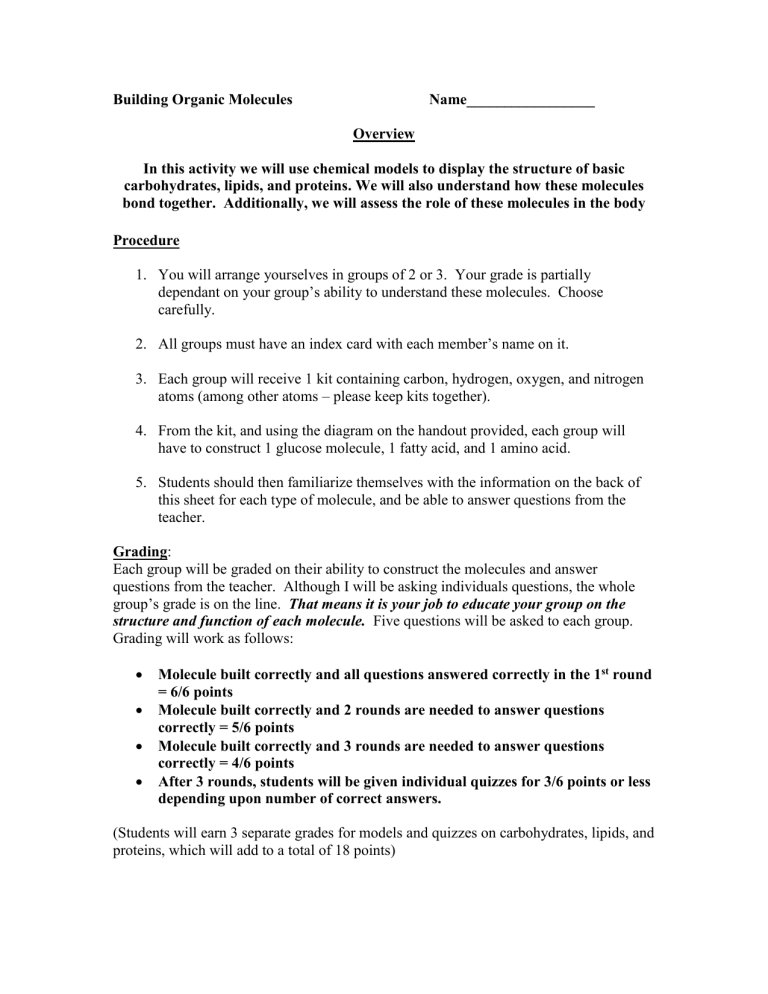
Building Organic Molecules Name_________________
Overview
In this activity we will use chemical models to display the structure of basic carbohydrates, lipids, and proteins. We will also understand how these molecules bond together. Additionally, we will assess the role of these molecules in the body
Procedure
1.
You will arrange yourselves in groups of 2 or 3. Your grade is partially dependant on your group’s ability to understand these molecules. Choose carefully.
2.
All groups must have an index card with each member’s name on it.
3.
Each group will receive 1 kit containing carbon, hydrogen, oxygen, and nitrogen atoms (among other atoms – please keep kits together).
4.
From the kit, and using the diagram on the handout provided, each group will have to construct 1 glucose molecule, 1 fatty acid, and 1 amino acid.
5.
Students should then familiarize themselves with the information on the back of this sheet for each type of molecule, and be able to answer questions from the teacher.
Grading :
Each group will be graded on their ability to construct the molecules and answer questions from the teacher. Although I will be asking individuals questions, the whole group’s grade is on the line.
That means it is your job to educate your group on the structure and function of each molecule.
Five questions will be asked to each group.
Grading will work as follows:
Molecule built correctly and all questions answered correctly in the 1 st round
= 6/6 points
Molecule built correctly and 2 rounds are needed to answer questions correctly = 5/6 points
Molecule built correctly and 3 rounds are needed to answer questions correctly = 4/6 points
After 3 rounds, students will be given individual quizzes for 3/6 points or less depending upon number of correct answers.
(Students will earn 3 separate grades for models and quizzes on carbohydrates, lipids, and proteins, which will add to a total of 18 points)
Information each group should know after constructing their glucose molecule:
The structure of the molecule.
How this molecule compares to other monosaccharides, disaccharides, and polysaccharides.
Be able to show (will need help of teacher’s glucose molecule to do this) how disaccharides and polysaccharides would form.
The processes which break down polysaccharides and build di- and polysaccharides.
The role of glucose and glycogen in the body
Information each group should know after constructing their lipid molecule:
The structure of the molecule.
Whether this is a saturated or unsaturated fat – and how you can tell the difference.
The monomers that make up this polymer.
The processes which break down and build lipids.
The role of lipids in the body.
Information each group should know after constructing their amino acid molecule:
The structure of the molecule.
How each amino acid is different from one another.
The polymer that these monomers join to build.
The bond that holds two amino acids together.
The processes which break down proteins/polypeptides and build them.
The role of proteins in the body.

